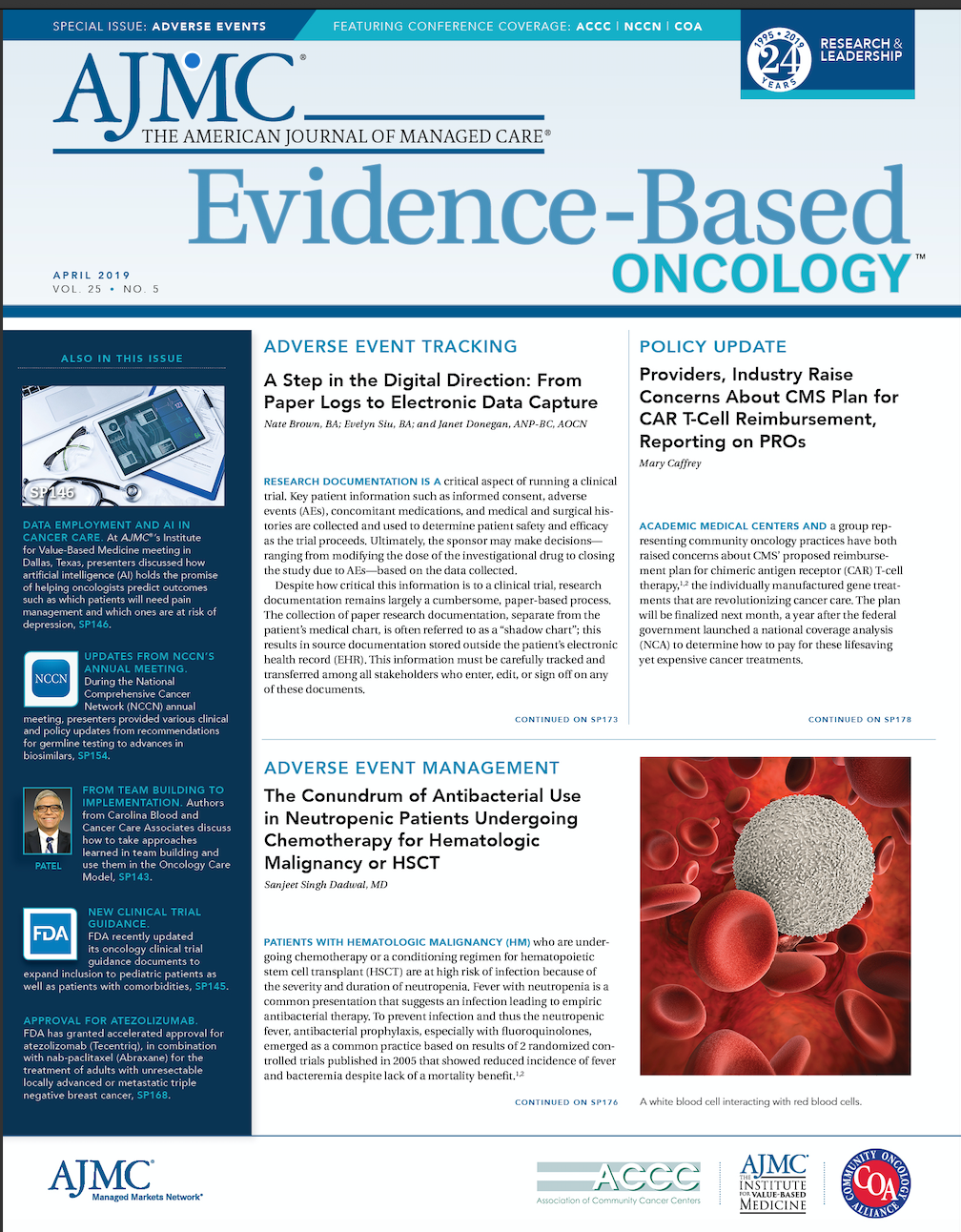- Center on Health Equity & Access
- Clinical
- Health Care Cost
- Health Care Delivery
- Insurance
- Policy
- Technology
- Value-Based Care
From the Editor-in-Chief: Oncology in the Time of "Moore's Law"
In an article published in Electronics Magazine on April 9, 1965, Intel cofounder Gordon Earle Moore noted that the number of transistors in an integrated circuit doubled every year. He extrapolated that this rate of growth in computing power would continue to double every 2 years throughout the late 1960s and in to the 1970s and 1980s. The prediction, which became known as Moore’s Law, proved prescient. Intel and other industry leaders took this as both a prediction for the pace of innovation and a push for the industry to create “computing [that] would dramatically increase in power, and decrease in relative cost, at an exponential pace.” From 1965 to today, the technologies, depth of innovation, and corresponding impact from discoveries made in the pursuit of achieving and sustaining Moore’s vision have affected our lives in profound and unexpected days. Conversations rarely take place today without someone glancing at a smartphone to close a business deal, to let family know they will be late, or to post pictures of the conversation on a social media site.
In an article published in Electronics Magazine on April 9, 1965, Intel cofounder Gordon Earle Moore noted that the number of transistors in an integrated circuit doubled every year.1 He extrapolated that this rate of growth in computing power would continue to double every 2 years throughout the late 1960s and in to the 1970s and 1980s. The prediction, which became known as Moore’s Law, proved prescient. Intel and other industry leaders took this as both a prediction for the pace of innovation and a push for the industry to create “computing [that] would dramatically increase in power, and decrease in relative cost, at an exponential pace.”2 From 1965 to today, the technologies, depth of innovation, and corresponding impact from discoveries made in the pursuit of achieving and sustaining Moore’s vision have affected our lives in profound and unexpected days. Conversations rarely take place today without someone glancing at a smartphone to close a business deal, to let family know they will be late, or to post pictures of the conversation on a social
media site.
Oncology is now in the midst of realizing its own Moore’s Law. Some speculate that data generated in oncology are doubling at a rate of every 3.5 years. A recent IQVIA report noted, “Over the past 5 years, 61 cancer drugs, each approved in 1 or more tumors, have impacted the treatment of 23 different cancer types.”3 This level of innovation has translated into an enormous human impact. The American Cancer Society found that over the past 25 years, the cancer death rate has declined by 27% and that this decline “translates to about 1.5% per year and more than 2.6 million deaths avoided between 1991 and 2016.”4 Numerous industry leaders are positioning themselves for a big data revolution in oncology in which the almost unfathomable amount of data compiled from the growing field of genomic testing can be integrated with discreet patient data and innovative therapeutics to bring better care faster to patients affected by cancer.5
Inasmuch as new data in oncology are translating into a wealth of new information that may be leveraged to deliver far more effective treatments to patients affected by cancer, new and significant challenges are popping up in this time of extraordinary innovation. Unlike the marked relative decline in the costs of integrated chip-based devices, costs in new
and innovative cancer treatments have grown dramatically. The IQVIA report notes3:
Spending on cancer drugs in the United States has doubled since 2012 and reached almost $50 billion in 2017, with two-thirds of the growth tied to use of drugs launched within the past 5 years. ... Spending on cancer medicines is heavily concentrated, with the top 35 drugs accounting for 80% of total spending.3
Moreover, although oncology drug costs are growing at a rapid—some would say an unsustainable—pace there are additional challenges to the oncology delivery system based on issues of patient access to care, provider knowledge gaps, and the challenges related to the still-unresolved question of how to more effectively manage social determinants of health.
Some of the goals of Evidence-Based Oncology™ are to disseminate information regarding key innovations in oncology care while also working to engage key stakeholder thought leaders in conversations geared at translating the extraordinary innovations of “oncology in the time of Moore’s Law” into a clinically effective, equitably available, and financially sustainable system of care delivery.
In this month’s issue, we have the opportunity to learn about advancing care technologies and discuss some of the financial and practical challenges of sustainably delivering these innovations. These include clinical updates from the National Comprehensive Cancer Network (NCCN) on ovarian and prostate cancers and shining a spotlight on the growing importance of immunotherapy in the care of patients with non—small cell lung cancer. Sanjeet Dadwal, MD, from City of Hope, in Duarte, California, summarizes what is new in supporting and managing patients with febrile neutropenia. The challenges and opportunities of delivering new care technologies at a sustainable price point are explored in discussions from NCCN on biosimilars, end-of-life care, and survivorship. We also explore the great opportunities and enormous financial challenges of delivering chimeric antigen receptor T-cell therapeutics in panel discussion.
There have never been greater opportunities for patients to survive heretofore ineffectively treated cancers. The growing development of targeted therapeutics and the rapidly expanding domain of immune-oncology portend even greater abilities to serve patients with historically unmet cancer care needs. We have the ability to move forward into this
new era of knowledge, with greater opportunity for cures, more equitable and navigable systems of care, and sustainable costs.REFERENCES:
- Computer History Museum. 1965: “Moore’s Law” predicts the future of integrated circuits. The Silicon Engine website. www.computerhistory.org/siliconengine/moores-law-predicts-the-future-of-integratedcircuits/. Accessed March 31, 2019.
- Fueling innovation we love and depend on. Intel website. intel.com/content/www/us/en/silicon-innovations/moores-law-technology.html. Accessed March 31, 2019.
- Aitken M, Kleinrock M, Simorellis A, Nass D. Global oncology trends 2018: innovation, expansion, disruption. IQVIA website. iqvia.com/-/media/iqvia/pdfs/institute-reports/global-oncology-trends-2018.pdf?_=1554047050142. Published May 2018. Accessed March 31, 2019.
- Simon S. Facts and figures 2019: US cancer death rate has dropped 27% in 25 years. American Cancer Society website. cancer.org/latest-news/facts-and-figures-2019.html. Published January 8, 2019. Accessed March 31, 2019.
- Neropol NJ. Opportunities for using big data to advance cancer care. Clin Adv Hematol Oncol. 2018;16(12):807-809.

Trends in Hospital Pricing for Vulnerable Emergency Department Users, 2021-2023
December 4th 2025Self-pay emergency department prices rose significantly from 2021 to 2023, especially at for-profit and system-affiliated hospitals, highlighting growing affordability challenges for uninsured and underinsured patients.
Read More
Exploring Racial, Ethnic Disparities in Cancer Care Prior Authorization Decisions
October 24th 2024On this episode of Managed Care Cast, we're talking with the author of a study published in the October 2024 issue of The American Journal of Managed Care® that explored prior authorization decisions in cancer care by race and ethnicity for commercially insured patients.
Listen
Integrated Care for Chronic Conditions: A Randomized Care Management Trial
December 3rd 2025The authors sought to understand the differential impact of payer-led community-based care management approaches on stakeholder-oriented outcomes for publicly insured adults with multiple chronic conditions.
Read More

